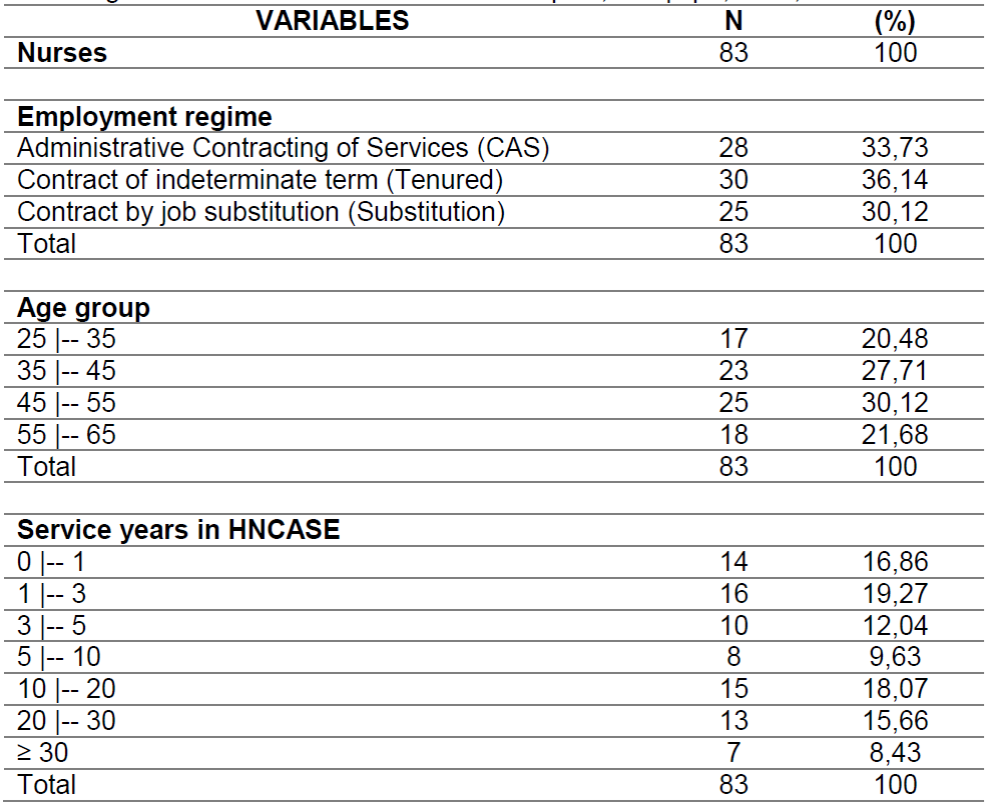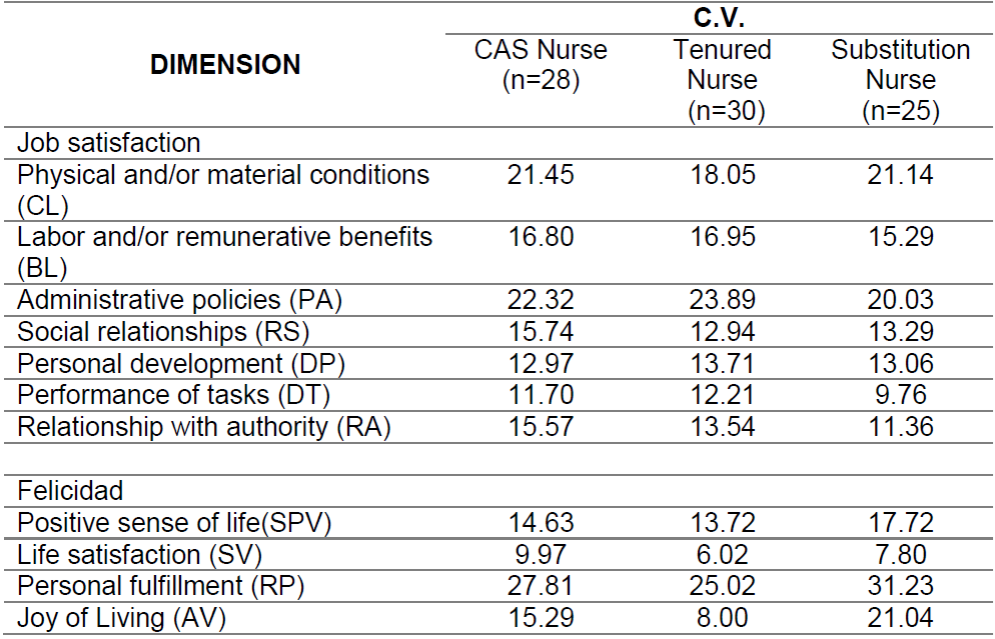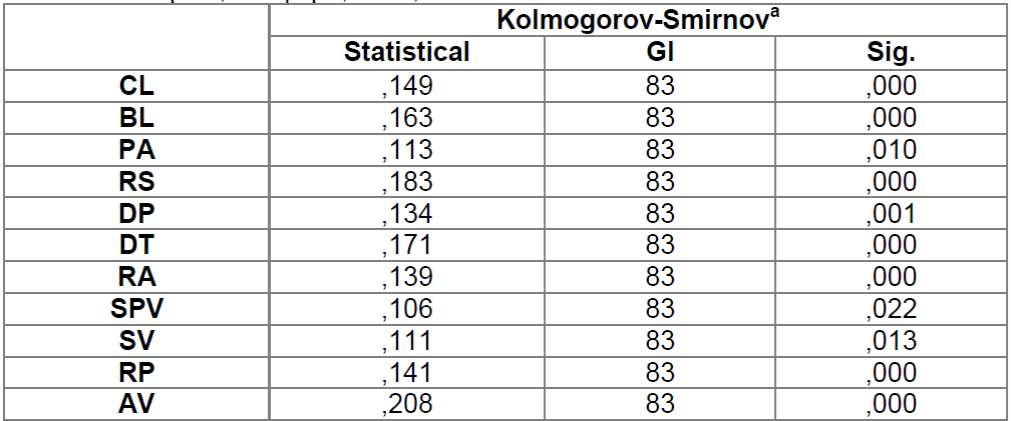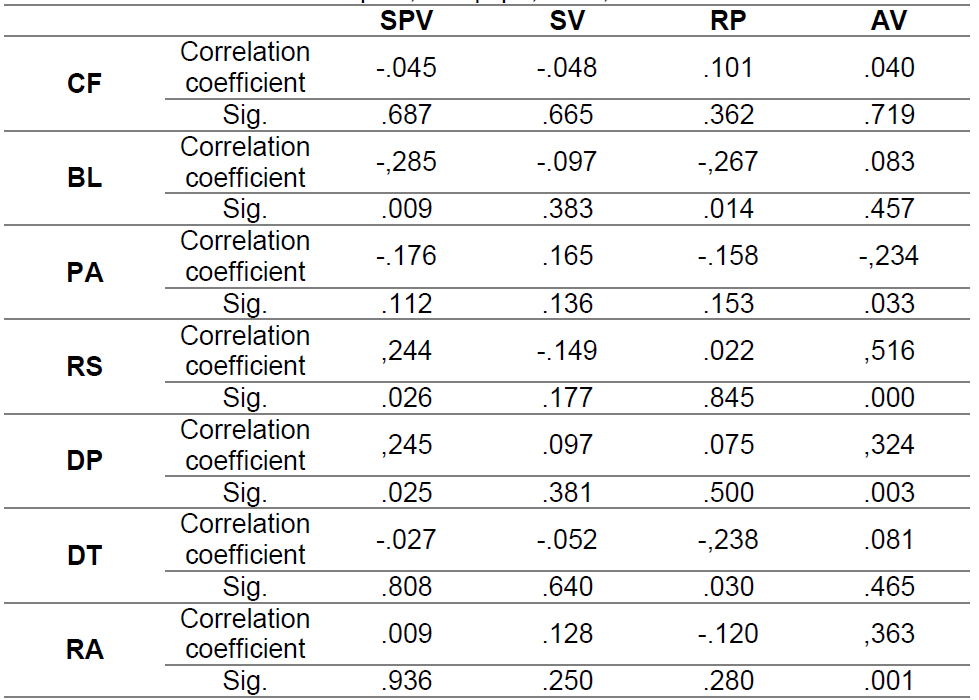My SciELO
Services on Demand
Journal
Article
Indicators
-
 Cited by SciELO
Cited by SciELO -
 Access statistics
Access statistics
Related links
-
 Cited by Google
Cited by Google -
 Similars in
SciELO
Similars in
SciELO -
 Similars in Google
Similars in Google
Share
Enfermería Global
On-line version ISSN 1695-6141
Enferm. glob. vol.18 n.54 Murcia Apr. 2019 Epub Oct 14, 2019
https://dx.doi.org/10.6018/eglobal.18.2.334741
Originals
Job satisfaction and happiness in Peruvian nurses
1Universidad Católica de Santa María. Arequipa-Perú.
Objective:
To analyze the relationship between job satisfaction and happiness in the nursing staff of the Alberto Seguín Escobedo EsSalud National Hospital in the city of Arequipa (Peru).
Methods:
Using the quantitative method and the non-experimental, transversal-correlational design, the SL-SPC Labor Satisfaction Scale of Palma (1999) and the Happiness Scale of Alarcón (2006) were applied to a sample of 83 workers, among the 25 to 65 years old, who work as nurses.
Results:
It was found that the dimensions with higher job satisfaction in nurses are "personal development" and "task performance" (≥70, in both cases). In the case of the Happiness variable, it was identified that the "Satisfaction with Life" dimension is the one with the highest valuation (≥90, in all three cases). On the other hand, the study identified the existence of direct and inverse correlations between the study variables.
Conclusion:
Positive associations were observed between dimensions of job satisfaction and happiness factors. The companionship and the desire to achieve a goal of personal and professional development increases the sense of happiness that nurses perceive in their work life.
Key words: Job satisfaction; Happiness; Nurse; National Hospital Alberto Seguín Escobedo
INTRODUCTION
Job satisfaction as a positive or pleasant emotional state of subjective perception of the subject's work experiences refers to satisfaction as an emotional state where people, when making an assessment about their work environment, reflect their experiences in a subjective way to the variables that they experience in their work, and this is the principle to positively assimilate the environment and what will trigger the level of job satisfaction that this has of it.
Happiness or subjective well-being is defined as a state of individual evaluation in relation to life in terms of cognitive and affective aspects. It is a derivation of the field of positive psychology that is used to cultivate positive emotions among individuals to ensure positive impacts in their lives. It has been observed that in Malaysia subjective well-being is vital among nurses as they participate with a large number of patients with the shortage of nurses which affects their internal feelings, it is reflected in their performance and the result of the service1.
In China, the higher the levels of job satisfaction and work esteem, the stronger the subjective well-being will be. This is because the work pressure in the intensive care units cannot be temporarily relieved; therefore, nurses increase their self-esteem and job satisfaction through strategies aimed at reducing stress and companionship that strengthen psychological construction in a positive way2).Negative affect among co-workers reduces opportunities for interaction and the intention to leave the workplace3.
Evidence also highlights the importance of healthy lifestyle habits, including adequate nutrition, avoidance of tobacco and alcohol consumption, regular practice of physical activity together with general preventive behaviors, demonstrating that these contextual variables interfere with the subjective well-being of nurses, especially younger ones, who reside in rural areas and live with their families and who are slightly less physically active or overweight4.
Including the case of the United Kingdom, it was further identified that in the case of nurses who reside and work in urban centers, the demographic and workplace factors do not correlate with a high subjective well-being, however a correlation with the presence of mental health diseases was observed5.
Meanwhile, other studies have shown that the emotional factor and the job position presents a positive correlation, between positive emotions and job satisfaction of nurses, especially in relation to the general feeling of being psychologically in relation to their occupational safety6 7. It has been identified, that nurses who have job stability and greater experience show a greater ability to adapt to the work environment, autonomy, confidence, self-acceptance of themselves8and sense of material well-being, showing that the most important aspects for job satisfaction of nurses is salary, followed by staff and benefits9.
Given the importance of understanding this critical situation that negatively affects the professional capacity of nurses, visible through a constant labor waiver (continuous rotation of personnel) which in turn leads to economic costs, investment of overtime in the induction of new workers, interruptions in the planning of the work areas, uncertainty in the old workers, giving way to an inadequate work environment, not harmonious and not warm, as well as the non-development of perspectives of personal and professional growth within from the work center and a negative sense of happiness arose the need to answer the questions: Is there a direct relationship between job satisfaction and happiness in the nursing staff? What are the factors that have the highest incidence in job satisfaction and the happiness of nurses?
To answer such questions, the present study has as a general objective to analyze the relationship between job satisfaction and the happiness of the nursing staff. In addition, it is important, as specific objectives, to describe levels of job satisfaction; describe happiness factors; and identify and analyze the existing relationships between these levels and factors in nursing workers.
MATERIAL AND METHODS
The investigation comprised three stages, covering a total of 06 months. In the first stage of the research, which covers the months of November and December 2017, a review of the literature was developed by means of secondary sources such as books, specialized journals, consultations in databases on the Internet and the support of specialized researchers in the subject to guide the selection of subjects and media to study. The second stage, which included the months of January, February and March of 2018, consisted of the collection of information from primary sources. Finally, in the following month, a connection was made between the theoretical and the cases studied to respond to the main objective.
The study corresponds to non-experimental, transversal-correlational design, for which the quantitative method was used as a general method and as specific to the methods, analogical and inferential statistics. In addition, the study population included the nursing staff that currently works in the different areas of the HNCASE. The representative sample was of 83 nurses, of whom a third part are tenured nurses, the following third are contracted under the modality CAS (Administrative Contracting of Services) and the remaining percentage that is under the labor regime of hiring by temporary substitution. The ages of the study sample range from 25 to 65 years of age and belong to different areas of work. The inclusion criteria were based on considering as a study sample only female nurses, with more than 6 months of service and who have not invalidated the assessment instruments. The type of sampling is probabilistic - stratified.
For fieldwork purposes, two different types of tests were applied to the selected sample. To determine job satisfaction, the SL-SPC job satisfaction scale elaborated by S. Palma (1999) (10) was applied. This instrument of psychological exploration allowed us to evaluate the level of job satisfaction of workers in the sample selected under a test consisting of 36 items, designed under the Likert scale, which address 7 factors: I. physical and/or material conditions, II. labor and/or remunerative benefits, III. administrative policies, IV. social relations, V. personal development, VI. performance of tasks and VII. relationship with authority. The application can be individual or collective with a duration of 20 minutes. And, finally, the Scale of Happiness of Alarcón (2006)11was applied, which is composed of 27 items constructed according to a Likert scale of five alternatives: totally agree, agree, neither agree nor disagree, disagree and totally disagree. The positive end has a value of five points and the negative end has one point. In the questionnaire, the items are randomly distributed. According to the total score, it is divided into five happiness levels: from 27-87: very low happiness; 88-95: low; 96-110: average; 111-118: high; 119-135: very high. The application can be individual or collective with a duration of between 15 minutes.
The application of the two instruments was carried out on different dates in a period of three months. This is due to the different activities carried out by the staff on a daily basis, for which specific dates and times were scheduled in accordance with the amount of weekly work assigned to the staff, the schedules with the least workload and the face-to-face availability of the sample subgroups within the HNCASE facilities. In each case, each instrument that was applied to the selected sample was made during work hours, for which authorization was requested from the general management.
The application methodology was carried out individually, in which the worker was explained the objective of the evaluation, the instructions on how to answer the questions raised in each of the instruments. Likewise, the indications and response alternatives were read progressively with the purpose that the worker understands comprehensively the purpose of each of the questions and the progress of the filling of the instrument is progressive, allowing to reduce the possibility of a fast filling and not objective on the part of the selected sample. In addition, any questions or concerns of the evaluated person were immediately answered. Subsequently, the data was processed to determine the relationships between the variables, the results were interpreted and the discussion, conclusions and recommendations of the case were made.
The collected information was processed, classified, systematized and analyzed according to the corresponding units of analysis, with regard to its variables and indicators, through the statistical program SPSS 22.0, in order to clarify conceptually the relationship between job satisfaction and happiness of the care personnel of health of the National Hospital Carlos Alberto Seguín Escobedo of EsSalud - Arequipa.
The study was approved by the Institutional Research Ethics Committee of the Catholic University of Santa María (CIEI-VI-UCSM No. 12-2018, approval date 3.14.2018). The ethical requirements of the research to conduct research in humans were met in the hospital chosen for the study, as well as in the university of researchers.
RESULTS
The sample consisted of 83 nurses, 30 (36.14%) tenured, 28 (33.73%) contracted according to the CAS regimen and 25 (30.12%) who are working in the substitution modality. The mean age of the participants was 37.22 ± 10.85 years, ranging from 32 to 50 years. An average of 10.59 ± 7.63 years was observed for years of professional service in the HNCASE. The majority of the nurses developed assistance activities in the hospital center. (Table 1).
Table 1. Sociodemographic variables of the investigated nurses (n = 83). Carlos Alberto Seguín Escobedo EsSalud National Hospital, Arequipa, Peru, 2018.

Source: Investigation data, 2018.
The instruments used were subjected to the reliability evaluation, using the Cronbach's Alpha coefficient, presenting values that ranged from 0.71 to 0.79 for the SL-SPC and 0.82 to 0.87 for the Happiness Scale, evidencing good internal consistency
Regarding job satisfaction, it was observed that CAS nurses show greater disagreement (≤25%) in relation to "physical and/or material conditions", "social relationships" and "relationship with authority"; meanwhile, the tenured nurses show greater disagreement (≤ 25%) regarding to "labor and/or remunerative benefits", "administrative policies", "personal development" and "performance of tasks". On the other hand, in nurses by substitution, no item of majority disagreement predominates; on the contrary, they are the ones that show greater conformity (≤ 25%) on the dimensions "labor and/or material benefits", "administrative policies", "performance of tasks" and "relationship with authority".
On the other hand, as far as happiness is concerned, it is nurses by substitution who present the most disagreement (≤ 35%) in almost all the aspects referred to: "positive sense of life", "personal fulfillment" and "joy of living". On the opposite side, the tenured nurses show the majority positive sense of happiness (≤ 35%) compared to the other patients. And the CAS nurses are at the midpoint in relation to the other two cases studied (Table 2).
Table 2. Variability coefficient of the investigated nurses (n = 83). Carlos Alberto Seguín Escobedo EsSalud National Hospital, Arequipa, Peru, 2018.

Source: Investigation data, 2018.
To determine the correlation between the variables, the analysis of normality of data was performed, finding in all cases a non-parametric distribution. Kolmogórov-Smirnov test was used (Table 3).
Table 3. Analysis of data normality, Carlos Alberto Seguín Escobedo EsSalud National Hospital, Arequipa, Peru, 2018.

Source: Investigation data, 2018.
In view of the results of the data behavior, the Spearman RHO test was used to identify the correlation between the variables (Table 4).
DISCUSION
Verifying the relationship between job satisfaction and the happiness of the nursing staff is of utmost importance, since the level of both variables has been decreasing considerably in the number of workers as the years of service are being accumulated, despite Management's efforts of the hospital for increasing the quality of life and work conditions. In addition, the present study makes it possible to identify the gaps in labor policies, especially the relationship between the labor and the personal level, in order to improve the organizational institutional environment, since this specific type of personnel works daily with the administrative, assistance, management, technical, services staff and patients in general.
The present study showed that the dimensions "personal development" and "performance of tasks" present greater satisfaction in nurses (≥70, in both cases). The questions with an assessment higher than 90% in the case studies were "I feel really useful with the work I do" and "I feel happy for the results I achieve in my work".
Similar results were reported in a sample of 300 nurses in the city of Bangalore (Karnataka, India), where it was identified that, unlike the medical staff, the nurses responded with higher valuation to questions regarding "personal growth" and "satisfaction with the tasks performed"12.
On the other hand, in all three cases it was also observed that the dimensions "physical and/or material conditions" and "administrative policies" are the aspects of greatest dissatisfaction for nurses (≥70, in both cases). The assessments with the highest percentage of dissatisfaction (≥70) respond to "I feel I am giving more than what I receive from the institution" and "in the physical environment where I work comfortably".
A study of 640 nurses from 8 hospitals located in Slovenia coincided with the previous result showing that the aspects of "work space" and "self-acceptance" present high indices of disagreement among health workers13.
In the case of the Happiness variable, it was identified that the " Life Satisfaction" dimension is the one with the highest assessment by nurses (≥90, in all three cases). The questions with a rating greater than 90% in the case studies were "I am satisfied with my life" and "I feel satisfied with what I am".
Similar findings were reported in 1757 nurses from three public hospitals in China14and 252 nurses from six private hospitals in Tehran (Iran)15. In both cases, it was observed that the highest happiness levels respond to life satisfaction, specifically the "I am satisfied with the person I am" item.
On the opposite side, it was identified that the "Personal fulfillment" dimension is the one with the lowest assessment by the three study sub-samples (≥65, in all three cases). The questions with the lowest rating, around 10%, are: "I am satisfied with what I have achieved so far", "I feel satisfied because I am where I need to be" and "I feel like a realized person".
Similar results were identified in 309 nurses from eight medical centers16and in 73 nurses from the Shahid Sadoughi Hospital in Iran17. In the two reported cases, it was identified that the lower happiness percentages answer the questions: "I have not yet personally or professionally performed" and "I feel dissatisfied with my current work condition".
On the other hand, the study allowed to identify the existence of a direct correlation between the factors "Social Relations" with "Positive Sense of Life" and "Joy of Living"; "Personal Development" with "Positive Sense of Life" and "Joy of Living"; "Task Performance" with "Personal fulfillment"; and "Relationship with Authority" with "Joy of Living."
In addition, an inverse correlation was identified between "Labor and/or Remuneration Benefits" with "Positive Sense of Life" and "Personal fulfillment"; "Administrative Policies" with "Joy of living "; and "Performance of tasks" with "Personal Fulfillment".
The study leads us to a broad reflection of the way in which labor policies manifest themselves around the sense of happiness perceived by nurses. The work context is presented as a space devoid of material conditions that help to generate a satisfactory sense of happiness in nurses.
The physical environment, the contractual relationship, the hierarchical relations and the assigned tasks are predominantly seen as negative aspects that situate the labor context as a distant, wild and disconforming space. However, it has been observed that this problem has been taken to a secondary level, which has strengthened the bonds of friendship and companionship among the nurses as compensation to give a positive meaning to the lives of the nurses, but above all to the nurses. work they do.
In this regard, it is necessary to reflect on the state of nurses' subjective well-being, critically re-examining current labor policies and reorienting them towards a more human side, taking into account the need to distance them from generating a mechanical, repetitive work environment. instrumental where the workers feel satisfied with the work they do and can achieve a full and integral life satisfaction.
CONCLUSION
The results found in the study allow to conclude the level of job satisfaction of the nurses studied is low, especially in the dimension "Administrative Policy", and particularly manifested a greater dissatisfaction in the tenured nurses. And, the highest job satisfaction is found in the "Task Performance", highlighting the nurses by substitution.
About Happiness, it is observed that in all three cases the factor where a greater sense of happiness prevails is the " Life Satisfaction", appearing with greater force in the tenured nurses. And, where happiness is lower lies in the "Personal Fulfillment", especially in nurses by substitution.
A direct correlation is observed between the dimensions "Social relations" and "Personal development" of the Labor Satisfaction with the "Joy of living" factor of the Happiness variable, which explains that the nurses, as a result of the institutional labor policy, have separated the personal dimension (including the family question) from its scope of work. Likewise, the study sample, being within a precarious administrative policy, unsTable and without attractive benefits that allow the personal and professional fulfillment, have filled that void reinforcing the amical bonds with their labor social networks (coworkers), granting them a positive sense of happiness to the work they perform on a daily basis. The companionship and the desire to achieve a goal of personal and professional development increases the sense of happiness that nurses perceive in their work life.
Acknowledgment
To the nursing staff of HNCASE - National Hospital Alberto Seguín Escobedo EsSalud, for their valuable help and detached cooperation.
REFERENCES
1. Tahir NKM, Hussein N, Samad S. Workload and Subjective Well-Being Among Nurses in Malaysia. Advanced Science Letters. 2017; 23(8):7853-7856. [ Links ]
2. Liu H, Zhang X, Chang R, Wang W. A research regarding the relationship among intensive care nurses' self-esteem, job satisfaction and subjective well-being. International Journal of Nursing Sciences. 2017; 4:291-295. [ Links ]
3. Gurková E, Haroková S, Dzuka J, Ziaková K. Job satisfaction and subjective well-being among Czech nurses. International Journal of Nursing Practice. 2014;20(2):194-203. [ Links ]
4. Chaves C, Duarte J, Campos S, Martins M, Ferreira M, Coutinho E. Relation the lifestyle and subjective well-being in nursing students. Paper presented at 7th International Conference on Education and Educational Psychology. Greece, Rhodes; 2016. [ Links ]
5. Oates J, Jones J, Drey N. Subjective well-being of mental health nurses in the United Kingdom: Results of an online survey. International Journal of Mental Health Nursing. 2017; 26(4):391-401. [ Links ]
6. Gurková E, Ziaková K, Durisková M. Job satisfaction and emotional subjective well-being among Slovak nurses. International Nursing Review. 2012; 59:94-100. [ Links ]
7. Joulain M. Coulombier J. Liens entre vécu au travail et bien-être subjectif des infirmier(ère)s : des effets réciproques. Psychologie du travail et des organisations. 2016; 22: 205-215. [ Links ]
8. Blumberga S, Olava S. Quality of Hospital Nursing Work Life, Psychological and Subjective Well-Being. Rural Environment Education Personality. 2016; 13:295-300. [ Links ]
9. Sparksks S, Corcoran KJ, Nabors LA, Hovanitz CA. Job Satisfaction and Subjective Well-Being in a Sample of Nurses. Journal of Applied Social Psychology. 2005; 35(5):922-938. [ Links ]
10. Palma S. Elaboración y Validación de Escala SL-SPC en trabajadores de Lima. Metropolitana. Revista Teoría e Investigación en Psicología. 1999; 9(1):27-34. [ Links ]
11. Alarcón R. Desarrollo de una Escala Factorial para Medir la Felicidad. Interamerican Journal of Psychology. 2006; 40(1):99-106. [ Links ]
12. Madhuchandra MK, Srimathi NL. Psychological Well-being among Doctors and Nurses: A Comparative Study. The International Journal of Indian Psychology. 2016; 3(4):203-210. [ Links ]
13. Lorber M, Treven S, Mumel D. The importance of monitoring nurses' workplace satisfaction of nurses for the well-being of all employees in nursing. Obzornik zdravstvene nege. 2015; 49(3):182-189. [ Links ]
14. Abdollahi A, Abu Talib M, Yaacob SN, Ismail Z. Hardiness as a mediator between perceived stress and happiness in nurses. Journal of Psychiatric and Mental Health Nursing. 2014; 21(9):789-796. [ Links ]
15. Liu R, Zeng P, Quan P. The Role of Hope and Self-efficacy on Nurses' Subjective Well-being. Asian Social Science. 2018; 14(4):18-22. [ Links ]
16. Mirfarhadi N, Moosavi S, Tabari R. Life satisfaction and its determinants: a survey on Iranian nurses population. Journal of Paramedical Sciences. 2013; 4(4):11-15. [ Links ]
17. Rahighee F. A Descriptive Study of Nurses' Happiness at Shahid Sadoughi Hospital, Iran. Journal of Mental Disorders and Treatment. 2015; 1(1):1-3. [ Links ]
Received: June 18, 2018; Accepted: August 07, 2018











 text in
text in 



